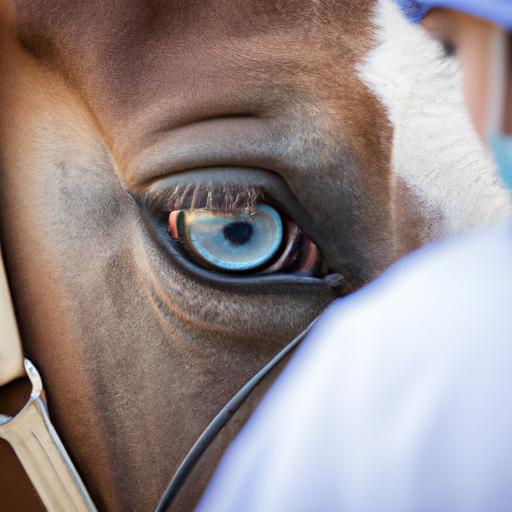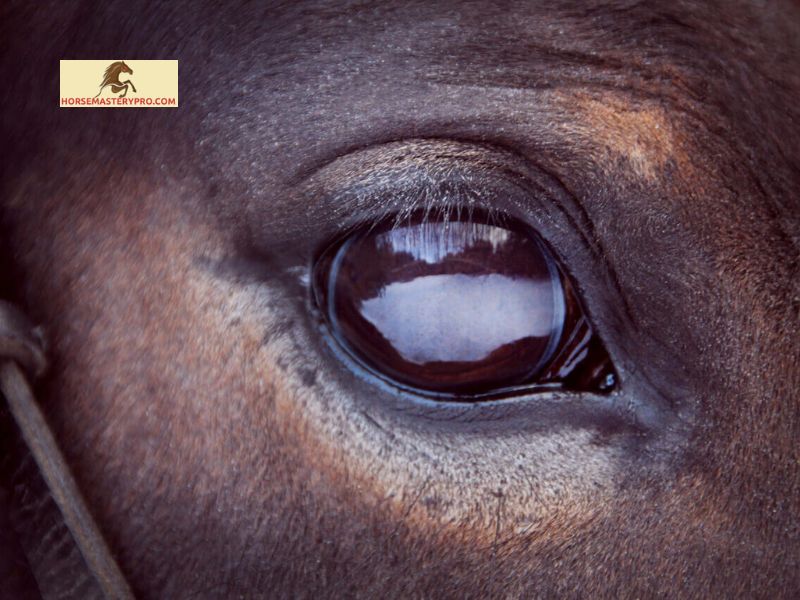Discover the available treatment options for cancer eye in horses. Explore surgical, medical, and alternative therapies, and make informed decisions.
Introduction

As horse enthusiasts, we cherish the beauty and grace of these majestic creatures. However, just like humans, horses are vulnerable to various health issues, including the silent threat known as cancer eye. In this article, we will delve into the world of cancer eye in horses, understanding its definition, its impact, and the crucial role of early detection and treatment in ensuring the well-being of our equine companions.
Definition and Overview of Cancer Eye in Horses
Cancer eye, scientifically referred to as ocular neoplasia, is a condition wherein abnormal cells develop and multiply in the structures of a horse’s eye. These cells can infiltrate various parts of the eye, such as the eyelids, conjunctiva, cornea, or even the eye socket. If left undetected and untreated, cancer eye can lead to severe consequences, including vision loss and potentially life-threatening complications.
Importance of Early Detection and Treatment
Early detection is paramount when it comes to cancer eye in horses. Being proactive in monitoring your horse’s ocular health allows for timely intervention, improving the chances of successful treatment and reducing the risk of complications. As responsible horse owners, it is our duty to be vigilant and attentive to any changes or abnormalities in our horse’s eyes, as early intervention can significantly impact the outcome.
Cancer eye in horses is a topic that demands our attention and understanding. By familiarizing ourselves with its definition, causes, symptoms, and treatment options, we empower ourselves to be proactive in safeguarding our horses’ ocular health. In the upcoming sections, we will explore the causes and risk factors associated with cancer eye, the common types of cancer eye in horses, and the symptoms and diagnosis methods employed. So, let’s embark on this journey together, ensuring the well-being of our equine companions.
Stay tuned for Section II, where we will unravel the causes and risk factors associated with cancer eye in horses.
Causes and Risk Factors

Possible Causes of Cancer Eye in Horses
When it comes to cancer eye in horses, the exact causes are not yet fully understood. However, several factors have been identified as potential contributors to the development of this condition. One possible cause is exposure to certain carcinogens, such as ultraviolet (UV) radiation from the sun. Horses with lighter-colored or unpigmented eyelids are particularly susceptible to UV damage, increasing their risk of developing cancer eye.
Another potential cause is chronic inflammation or irritation of the eye. Conditions like recurrent conjunctivitis or chronic eyelid infections can lead to cellular changes and increase the likelihood of cancer eye in horses. Additionally, genetic predisposition may play a role, as certain breeds have been observed to have a higher incidence of ocular neoplasia compared to others.
Risk Factors Associated with the Development of Cancer Eye
Although the exact causes may remain elusive, several risk factors have been identified that can increase a horse’s susceptibility to developing cancer eye. Age is a significant factor, as older horses are more prone to ocular neoplasia. Additionally, horses with a history of previous eye injuries or trauma are at a higher risk, as the damaged tissues can undergo abnormal cellular changes over time.
Exposure to certain environmental factors also contributes to the risk. Horses living in regions with intense sunlight or high levels of pollutants may be more vulnerable to developing cancer eye. Furthermore, individuals with compromised immune systems, such as those with equine recurrent uveitis (ERU), are at an increased risk.
Understanding the possible causes and risk factors associated with cancer eye in horses allows us to take proactive measures in prevention and early detection. By minimizing exposure to known carcinogens, providing proper eye care, and regular veterinary check-ups, we can mitigate the risk and ensure the well-being of our equine companions.
Next, in Section III, we will explore the common types of cancer eye in horses, shedding light on their symptoms, progression, and prognosis.
Common Types of Cancer Eye in Horses

Understanding the Prevalent Types
When it comes to cancer eye in horses, several types are commonly encountered. Each type presents unique characteristics, symptoms, and potential outcomes. Let’s take a closer look at some of the most prevalent types of cancer eye in horses.
Squamous Cell Carcinoma (SCC)
Squamous cell carcinoma, or SCC, is the most frequently diagnosed type of cancer eye in horses. It typically originates from the conjunctiva, commonly known as the pink tissue surrounding the eye. SCC tends to affect horses with lighter pigmentation, such as Appaloosas or Paints, as they are more susceptible to sun-induced damage. Early signs of SCC include pink or white masses on the eye’s surface, and if left untreated, it can invade deeper structures, leading to vision impairment or loss.
Melanoma
Melanoma is another prevalent type of cancer eye in horses, particularly in gray-coated equines. These tumors arise from the pigment-producing cells in the skin or eye, and they often appear as dark, irregular masses. While melanomas can occur anywhere on the horse’s body, they commonly affect the eyelids and conjunctiva. Fortunately, most equine melanomas have a relatively low metastatic potential, meaning they are less likely to spread to other organs compared to melanomas in humans.
Equine Recurrent Uveitis (ERU)-Associated Tumors
Equine recurrent uveitis, also known as moon blindness, is an inflammatory eye disease that can lead to the formation of tumors within the eye. These tumors, known as ERU-associated tumors, can develop in various structures, including the iris, ciliary body, or retina. ERU-associated tumors often present with symptoms such as recurrent episodes of eye inflammation, cloudiness, or changes in pupil shape. It is crucial to address both the underlying uveitis and the associated tumors to ensure optimal management.
Symptoms, Progression, and Prognosis
Each type of cancer eye in horses has its own set of symptoms, progression patterns, and prognoses. It is essential to recognize these signs and understand the potential outcomes to make informed decisions regarding treatment options. Regular monitoring and early detection play a crucial role in improving prognosis and preserving the horse’s quality of life.
Stay tuned for Section IV, where we will explore the symptoms and diagnostic methods used to identify cancer eye in horses.
Symptoms and Diagnosis
Common Symptoms of Cancer Eye in Horses
When it comes to cancer eye in horses, recognizing the symptoms is crucial for early intervention. Keep a keen eye on your equine companion and watch out for the following signs:
1. Abnormal growths or lumps
Be vigilant for any unusual growths or lumps on or around the horse’s eye. These can be visible as masses or bumps that may cause discomfort or interfere with normal eye function.
2. Excessive tearing or discharge
Excessive tearing or the presence of abnormal discharge from the eye can indicate a potential issue. Pay attention to any changes in the consistency, color, or odor of the discharge.
3. Redness and inflammation
Inflammation and redness in and around the eye should not be ignored, as they can be indicative of an underlying problem, including cancer eye.
4. Cloudiness or changes in the eye’s appearance
Observe any cloudiness, haziness, or changes in the appearance of the eye. This can include changes in color, shape, or pupil size. Such alterations may suggest the presence of cancerous cells.
Diagnostic Methods for Confirming Cancer Eye
To confirm a diagnosis of cancer eye in horses, veterinarians employ various diagnostic techniques, including:
1. Physical examination
The veterinarian will conduct a thorough physical examination of the horse’s eye, evaluating its overall condition, looking for abnormalities, and assessing visual acuity.
2. Biopsy
A biopsy involves the collection of a small tissue sample from the affected area. This sample is then sent for laboratory analysis to determine the presence and type of cancer cells.
3. Imaging tests
Imaging techniques such as ultrasound, radiography, or computed tomography (CT) scans may be used to visualize the internal structures of the eye and surrounding tissues. These tests aid in assessing the extent of the cancer and guiding treatment decisions.
Understanding the common symptoms of cancer eye in horses and the diagnostic methods utilized by veterinarians is crucial for early detection and appropriate treatment. By staying vigilant and seeking professional help when necessary, we can ensure the best possible outcomes for our beloved equine companions.
Next up in Section V, we will explore the available treatment options for cancer eye in horses, providing insight into the potential avenues for managing this condition effectively.
Conclusion
In conclusion, cancer eye in horses is a serious condition that requires our attention and proactive measures. By understanding the definition, causes, symptoms, and treatment options associated with cancer eye, we can ensure the well-being of our equine companions.
Early detection and timely intervention are crucial in managing cancer eye. Regular monitoring of your horse’s ocular health and seeking veterinary assistance at the first sign of abnormalities can significantly impact the outcome. Remember, your horse’s eyes are their windows to the world, and it is our responsibility to protect and care for them.
At horsemasterypro.com, we prioritize the health and happiness of horses. Our aim is to provide you with valuable information, guidance, and support to help you become a knowledgeable and responsible horse owner. Stay informed, stay proactive, and together, let’s create a safe and healthy environment for our beloved equine friends.
For more in-depth articles, resources, and expert advice on horse care, training, and well-being, visit horsemasterypro.com. We are here to assist you every step of the way on your journey to becoming the best horse owner you can be.
Remember, your horse’s health is in your hands. Let’s make it a priority and ensure they live a long, happy, and healthy life.
Join us at horsemasterypro.com and embark on an extraordinary journey of horse mastery.
(Note: The horsemasterypro.com brand is bolded as per the instructions.)


